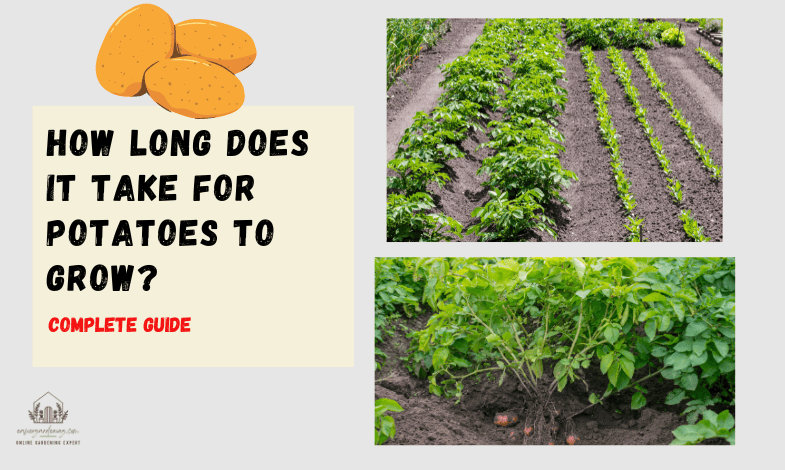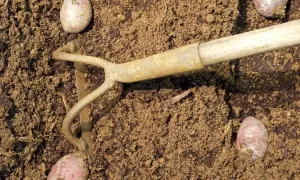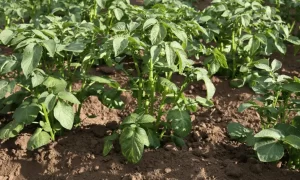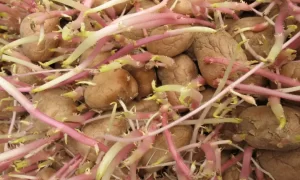How to plant potatoes? How long does it take for potatoes to grow? Well, Potatoes are easy to grow yourself in your garden. It is an important part of any self-sufficient garden. However, in addition to planting, mounding potatoes is also an important issue. With us, you will learn how to successfully plant potatoes and which tubers are suitable for this purpose.
Contents
- Which Potatoes can be Planted?
- Plant potatoes
- How Long does it take for Potatoes take to Grow?
- Planting potatoes: The right location
- Site and Soil properties for growing potatoes
- Pre-sprouting potatoes
- Planting potatoes: Spacing and depth
- Instructions
- Pile up Potatoes
- Final Thoughts: How long does it take for Potatoes to Grow?
- What month do you plant potatoes?
- Can you grow potatoes by planting a potato?
- Is Epsom salt good for potatoes?
- Are eggshells good for growing potatoes?
Which Potatoes can be Planted?
Before we tell you how to grow potatoes, you have to choose which potato to grow. What is the difference between normal table potatoes and seed potatoes? Basically, there is no difference between them. If you want to grow potatoes on a large scale, you have to buy seed potatoes from the grower. This ensures that no infected tubers and thus potato diseases come into circulation. Seed potatoes in all shapes and colors are available by the kilo in garden stores and from specialized growers.
Is it possible to plant normal potatoes? Of course, an amateur gardener may accidentally drop a potato from a bag of table potatoes into the soil and form new daughter tubers. However, many potatoes are treated with sprout-inhibiting agents to prevent them from starting to sprout in the storage closet. The agent migrates into the tuber after application, so it cannot simply be washed off. Therefore, when buying potatoes, make sure that they are untreated. In organic farming, such agents are generally prohibited.
Plant potatoes
Read more about How long does it take grass seed to grow?
Spring is the right time to plant potatoes – from the beginning of April to the end of May you can plant the tubers of potatoes. At this time, the soil should be medium-moist to dry and loose. For cultivation is also important to know the ripening time of each variety, that is, whether it is early potatoes or late.
How Long does it take for Potatoes take to Grow?
Now you are ready to ask how long it takes for potatoes to grow or what month you plant potatoes. Well, here is the list.
- First early potatoes – planting to harvest – 90 days.
- Plant in the middle of March. Harvest end of June/July.
- Second early potatoes – planting to harvest – 110 days.
- Plant in early April. Harvest July
- Medium early potatoes – planting to harvest – 135 days.
- Plant in mid to late April. Harvest from October.
- Late potatoes – planting to harvest – 160 days.
- Planting mid to late April. From October harvest.
Planting potatoes: The right location
Before you ask how to grow potatoes at home, you have to choose the right location to plant potatoes. For the potato to grow well, its soil requirements should be met and the optimal location for cultivation should be chosen. Potato plants prefer loose, well-drained as well as nutrient-rich soils in full-sun locations. Sandy soils and sandy loam soils are ideal for this. However, the potato also thrives in peaty and loamy soils, as long as the water can drain well. Waterlogging is not tolerated by it, in this case, the tubers rot quickly in the soil. The ideal soil pH is around 5.5 to 7.0. The plants tolerate calcareous soils well up to a pH of 8.5, but additional liming should then be avoided.
Site and Soil properties for growing potatoes
- Loose, rather sandy, well-drained, and nutrient-rich soil.
- No soils are prone to waterlogging, such as very loamy or clayey soils with poor drainage.
- The optimal soil pH is between 5.5 and 7.0.
- Follow crop rotation and change location from year to year.
- Alternatively, cultivate in pots with suitable potting soil.
In general, potatoes should never be grown several times in succession at the same location. Only after four years may they be returned to the same location. This prevents soil-borne potato diseases such as wart disease and one-sided soil fatigue.
Tips: Since the potato is a plant with quite high nutrient requirements, it is recommended to grow legumes (Fabaceae) such as beans (Phaseolus vulgaris) or peas (Pisum sativum) in the crop rotation the year before potatoes are grown.
Pre-sprouting potatoes
Seed potatoes can be pre-sprouted for four to five weeks beginning in early March on a bright, warm windowsill. This method ensures a two- to three-week earlier harvest and also allows varieties with an intermediate ripening time to be grown. In this way, they can usually be harvested before the dreaded late blight wreaks its havoc. However, you should take care that the partly long shoots of the germinated potato do not break off when planted out into the soil.
Tips: Potato tubers can also be divided. However, this must be done before sprouting, around the end of February. It is best to cut potatoes with a sterile, sharp knife and let the wound dry well. Both halves must have eyes – tiny buds. From these eyes will later form the shoots. If you divide the tubers in time, the potato will have long enough before planting out for the wound to heal and for pathogens not to take root.
Planting potatoes: Spacing and depth
The first question to ask when planting is: how deep do you plant potatoes? Planting and row spacing also play an important role in bed planning. The optimum planting depth for potatoes is 6 to 10 cm, and the planting distance between potatoes is 30 to 40 cm. The distance between rows should be 60 to 80 cm.
Instructions
From April to May begins the planting season for potatoes. With the help of a planting shovel, you can dig suitable holes for the tubers. Alternatively, use a garden hoe to make a long furrow and place the potatoes in it one by one. Pre-sprouted tubers are placed with the existing shoot facing upwards. Now cover the tuber with soil and water. After a few weeks, the first green shoots will then sprout out of the soil.
Pile up Potatoes
- The right time for mounding: when the shoots have reached an approximate size of 20 to 30 cm (in early cultivation it is possible to mound earlier).
- Pull soil lying around the potato plant towards the plant with a rake to form a mound.
- Mound soil around the potato plant so that the shoot sprouts are covered and only the shoot tips stick out.
- Remove weeds, eliminating competition for nutrients and water.
- Mounding can be repeated if necessary.
Final Thoughts: How long does it take for Potatoes to Grow?
In principle, potatoes can also be grown from seed, but in practice, only growers do this. For the amateur gardener, there are no advantages to sowing potato seeds. For one thing, pollination is very likely to have resulted in intermixing of varieties. The subsequent generation from the seeds is therefore probably not purely varietal.
Learn more about How long does bamboo plants live?
If you are here to know how long it takes for potatoes to grow, we must tell you, that seedlings take much longer to form tubers. The harvested tubers are quite small in the first year after the seeds are grown in February and thus hardly produce any yield. Only when the harvest from the first year is planted out in the following spring itself, the yield is approximately comparable.
Frequently Asked Questions
What month do you plant potatoes?
Depending on the weather of your area, you can plant potatoes in March, April or May, and expect a harvest about four months later. However, in mild-winter areas potatoes can be planted in the fall as well.
Read more about What To Plant After Potatoes? Everything you should Know
Can you grow potatoes by planting a potato?
Yes, after it sprouts, you can certainly plant the entire potato in the ground. However, another effective way to get more potatoes from one potato is by planting it from the eyes. To do that, first, you need to cut the potato into several smaller pieces. Then, leave one sprouted “eye” on each piece of potato.
Is Epsom salt good for potatoes?
Yes, Epsom salt is considered helpful when directly added to the soil of potato plants. Epsom salt offers a good boost of magnesium that is beneficial in stimulating biochemical reactions.
Are eggshells good for growing potatoes?
Yes. Like many other plants, potatoes like eggshells as well. The calcium in the eggshells helps with the fertility of the soil and the growth of the plant.




